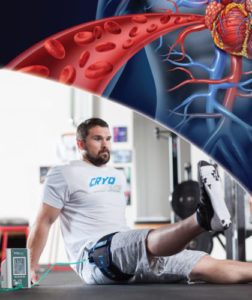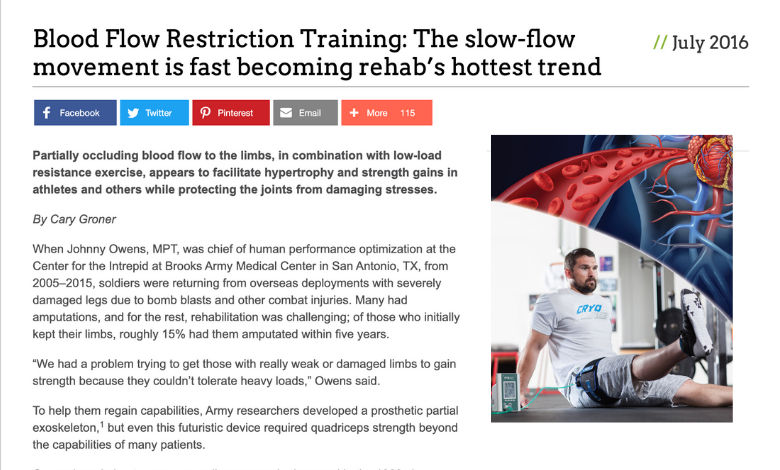Partially occluding blood flow to the limbs, in combination with low-load resistance exercise, appears to facilitate hypertrophy and strength gains in athletes and others while protecting the joints from damaging stresses.
 When Johnny Owens, MPT, was chief of human performance optimization at the Center for the Intrepid at Brooks Army Medical Center in San Antonio, TX, from 2005–2015, soldiers were returning from overseas deployments with severely damaged legs due to bomb blasts and other combat injuries. Many had amputations, and for the rest, rehabilitation was challenging; of those who initially kept their limbs, roughly 15% had them amputated within five years.
“We had a problem trying to get those with really weak or damaged limbs to gain strength because they couldn’t tolerate heavy loads,” Owens said.
To help them regain capabilities, Army researchers developed a prosthetic partial exoskeleton,1 but even this futuristic device required quadriceps strength beyond the capabilities of many patients.
Owens heard about a crazy-sounding approach pioneered in the 1980s by Japanese researchers, including Yoshiaki Sato, MD, PhD, and Takashi Abe, PhD, that involved partially occluding blood flow to the affected limb for short workouts.2,3 Owens did some reading, decided to give it a try, and found the results so promising that blood flow restriction (BFR) training soon became his specialty.4 He still puts in time at Brooks, but he believes BFR therapy may hold potential not only for those with war wounds, but also for high-level athletes and patients recovering from surgery. He’s now co-owner and director of clinical education at Owens Recovery Science, which is based in San Antonio but has clients nationwide.
Continue reading to learn why BFR training is gaining popularity in rehabilitation therapy.
When Johnny Owens, MPT, was chief of human performance optimization at the Center for the Intrepid at Brooks Army Medical Center in San Antonio, TX, from 2005–2015, soldiers were returning from overseas deployments with severely damaged legs due to bomb blasts and other combat injuries. Many had amputations, and for the rest, rehabilitation was challenging; of those who initially kept their limbs, roughly 15% had them amputated within five years.
“We had a problem trying to get those with really weak or damaged limbs to gain strength because they couldn’t tolerate heavy loads,” Owens said.
To help them regain capabilities, Army researchers developed a prosthetic partial exoskeleton,1 but even this futuristic device required quadriceps strength beyond the capabilities of many patients.
Owens heard about a crazy-sounding approach pioneered in the 1980s by Japanese researchers, including Yoshiaki Sato, MD, PhD, and Takashi Abe, PhD, that involved partially occluding blood flow to the affected limb for short workouts.2,3 Owens did some reading, decided to give it a try, and found the results so promising that blood flow restriction (BFR) training soon became his specialty.4 He still puts in time at Brooks, but he believes BFR therapy may hold potential not only for those with war wounds, but also for high-level athletes and patients recovering from surgery. He’s now co-owner and director of clinical education at Owens Recovery Science, which is based in San Antonio but has clients nationwide.
Continue reading to learn why BFR training is gaining popularity in rehabilitation therapy.
Blood Flow Restriction Training: The Slow-Flow Movement is Fast Becoming Rehab’s Hottest Trend


